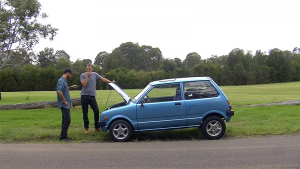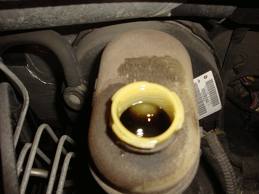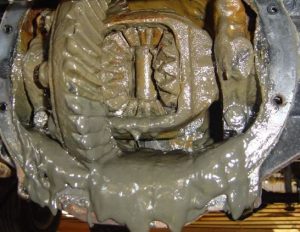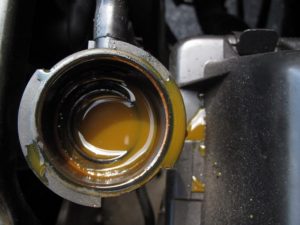A used car is an unknown car. Even with receipts it’s hard to know for sure whether required maintenance was done – and done correctly.
That second part being the intangible part.
A receipt indicating that the axle lube was changed – or the brake fluid flushed – is kind of like a Federal Reserve Note.
The work was probably done. But how well was it done? And was it done with the right parts? Including the right fluids? This latter is very important with late-model cars, which often require very specific fluids (e.g., synthetic oil or oil of a particular viscosity) not just for optimal performance but for the warranty coverage to remain in force. If there’s a failure down the road and you can’t prove that the required fluid was in fact used, you may find the warranty coverage doesn’t apply – leaving you holding the bag.
And failure is no fun, regardless.
Which is why my rule is to assume the worst – and service the just-bought used car on that assumption, as soon as possible after getting it home. I want to know what’s in the crankcase – the brand of oil, the weight and how much (dipsticks sometimes lie and quick-lube places are infamous for putting in more oil than the engine is supposed to take, or not enough – and either is bad).
I also want to know what brand of filter is hanging off the engine. A brand-new but low-quality filter is often worse than a high-quality one that’s been screwed onto the engine since three years ago.
Same goes for air filters. There may be a new-looking one in the air box. But is it a high-quality one – or the least expensive one the seller could find at Wal-Mart? Is it even the right filter? It’s not uncommon for someone to put the wrong one in. It’s close, but not quite – and so the seal’s not tight and unfiltered air (and dust and other friction-inducing things you don’t want in your engine) gets sucked in to your engine.
Confirming the condition of belts and hoses is also a good idea – and it’s much better to change them out in your garage, with all your tools on hand – and on your schedule – than by the side of the road, in the rain with whatever tools you can find.
I also want to know that the brake lines of the car I just bought are filled with fresh, uncontaminated fluid – not just that the master cylinder and the fluid in the reservoir looks clean. You can plainly see the master cylinder/reservoir – which is why the smart (but shady) used car seller will make sure it’s wiped clean and topped off with fresh fluid. But the fluid in the lines, you can’t see unless you open up the lines – and that’s hard to do on a used car dealer’s lot.
Which is why it’s one of the first things to do when you get that car home.
Dirty, water-laden brake fluid is death to expensive parts such as calipers and ABS pumps, as well as the lines themselves. Unless you know the fluid in them is clean and fresh, assume it’s not – regardless of what the seller (or the receipt he hands you) says.
Same goes for the clutch slave cylinder reservoir (in cars with manual transmissions) which also uses brake fluid, by the way. This fluid is frequently not changed per the maintenance schedule – if ever – because many people don’t even know their car has a slave cylinder, which uses hydraulic pressure (just like the brakes) to make engaging the clutch pedal less like doing leg presses at the gym.
But it’s a small neglect that can lead to a big hassle if the slave cylinder craps out on you on the road because it will be very hard to drive the car. The clutch pedal will go the floor -and stay there – just like the brake pedal does when a wheel cylinder blows out or there’s a leak in the line.
It’s also an expensive repair – especially if the car has its slave cylinder mounted inside the transmission case, as some do. Now you’re looking at dropping the transmission to replace a $75 part.
Checking – and replacing – what’s in the cooling system and transmission and axle (or transaxle) and transfer case, if it’s a 4WD truck or SUV is also sound policy if the car is used and unknown to you. Don’t forget the power steering pump reservoir, either. None of these components are cheap to replace but all of them can be easily killed by the use of cheap/incorrect (or not enough or too much) fluids.
Or fluids left in them for too long.
Additives dissipate, the chemicals which provided protection break down. It equals Bad News.
A croaked automatic transmission can hit you with a $4,000 bill – not counting the labor to R&R it. And most modern car engines are made of aluminum, which doesn’t tolerate overheating nearly as well as the heavier but much more tolerant of abuse cast iron engines of the past did. Risking a $6,000 engine for the sake of two $25 gallon jugs of coolant is a gamble not worth taking.
It is well worth your time to drain and refill everything with what you know to be the right stuff, in the right amount. And put in right.
By you.
Or by someone else you know to be someone who knows how to do it right.
Some will say this defeats the point of buying a used car vs. a new car – that point being to save money. But the cost of making sure fluids/filters are up to snuff and that all necessary maintenance has been done (and done right) is a very small expense, relative to the cost of both a new car payment and the cost of a major repair on that new used car you just bought.
. . .
Got a question about cars – or anything else? Click on the “ask Eric” link and send ’em in!
EPautos.com depends on you to keep the wheels turning! Clovers hate us!
Goo-guhl blackballed us!
Will you help us?
Our donate button is here.
If you prefer not to use PayPal, our mailing address is:
EPautos
721 Hummingbird Lane SE
Copper Hill, VA 24079
PS: EPautos magnets – they’re back! are free to those who send in $20 or more to support the site. Also, the eBook – free! – is available. Click here. Just enter you email in the box on the top of the main page and we’ll email you a copy instantly!













BrentP,
Delegation is indicated by your claiming to have given me “fair warning.”
Yes, warning that you will get treated in the same manner you’re dishing towards me.
Feel free to reciprocate in the same dismal style as you post.
This column is exactly why I ride a bike. Mine is beautiful and it cost about $1,500. It will last forever and I can easily do all the maintenance myself…even changing the drivetrain.
I’m not a tree hugging liberal but rather a pragmatic fiscal and social conservative. I didn’t always use a bike for transportation. I only started once I figured out I don’t have to register my bike with the government. I don’t have to buy insurance. I don’t buy gas, so I don’t fund wars for oil. My bike keeps me healthy…so no quadruple bypasses are on the horizon. I figure it’s saved me close to $250,000 over the last 10 years.
That said, I love your column. It reminds me of all the stuff I used to have to worry about but don’t any longer. Thank you for the catharsis. It’s much appreciated!
I’ve never seen a chain called a drivetrain. But then, I would never pay more than $150 for a bicycle. You should consider yourself lucky to not have to register your bicycle to use it on public thoroughfares. Give it time.
A drive-train on a bicycle consists of the chain, the chain rings (front sprockets), the cassette stack (rear sprockets) and the rear derailleur pulleys. The bottom bracket is also part of the drive-train but is not always replaced when the rest of the drive-train has worn out.
In addition, the shifters, cables and derailleurs are analogous to the transmission of a car and can be considered part of the drive-train of a bicycle. I suspect that Steven was referring to all, or most, of the above when he mentioned “changing the drivetrain”.
The gears, “shifters, cables and derailleurs” were a lot more analogous in the original automobiles that were made in bicycle shops with the available parts.
There could no other explanation for the automobilization of the bicycle.
What do you mean by “the automobilization of the bicycle”?
The use of bicycle parts to build automobiles?
Ah, I thought you meant that bicycles were becoming more like cars.
Jeremy
By going back to the antiquated and highly vulnerable to damage open chain? The only reason why bicycles haven’t gone to driveshafts like cars is because the majority of their customers wouldn’t pay for the excessive cost of the mechanism that would be required to provide more than one gear. As goes high end motorcycles will follow high end bicycles, if they can find a market.
Bill,
Drive shafts for bicycles were introduced in the late 19th century and proved to be vastly inferior to the open chain. They are significantly less efficient, at a similar drive-train weight, than a chain. To even approach the efficiency of a chain, the weight penalty would be severe (which is important if you are the power source).
The mechanism for multiple gears that will work with a drive shaft (an internally geared hub) has existed for more than a century. Even the best of these hubs are less efficient and heavier for a given gear range than an open chain. So, you add extra weight and less efficiency by going to a multi-speed shaft driven bike compared to an open chain bike. This is why the high end bike community has rejected them.
However, such a bike is very well suited to the needs of an urban commuter who is not concerned with maximizing efficiency and minimizing weight. The advantages for this type of bike for that purpose are clear: less maintenance, no dirty chain, less susceptible to damage from environmental grime, etc… And such bikes exist right now.
BTW, the major drawback to an open chain is that the necessary lubricant is exposed to the elements, which attracts grit and grime and contributes to wear and poorer performance. This problem can be mostly mitigated by maintaining a clean drive-train. Of course, this requires more maintenance, which is a trade-off deemed well worth it by the “high-end” bike community.
Finally, even that issue can be minimized significantly by lubricating the chain in a hot paraffin wax/paraffin oil mixture. This requires an initial thorough cleaning/degreasing of the drive-train. But, once done, this lubricant does not attract the grit that plagues other lubricants. The drive-train remains clean, lasts much longer and needs much less maintenance.
The open chain will be the choice of high end cyclists for the foreseeable future.
Jeremy
Jeremy, do you never use a dry lubricant? I’ve been considering it.
One reason is my region is very dirty and anything that won’t attract dirt is a boon. I changed to dry lubes for many things back in the 80’s and they saved a lot of cleaning and re-lubing(and wear).
Hi 8,
I’ve never found a “dry” lubricant marketed for bicycles that works very well. These are usually solvent based with some lubricating particulates suspended in the mixture. The theory is that you apply the lube and then the solvent base evaporates, leaving a “dry” film to lubricate the chain. But, every one I have tried provides poor lubrication and still attracts grit.
However, I would be interested in experimenting with other dry lubes that are not specifically marketed for bicycle use. Do you have any suggestions?
The best lube I have found so far is the hot paraffin wax/paraffin oil treatment described above. I did this to my road bike and mountain bike about 2 months ago and after over 25 rides on the MTB and about 20 on the road bike the drive-train is literally spotless. No dust or grime, I can rub my fingers across the chain and it transfers no residue at all. The MTB trails in SF are very dusty. My bike is coated with a thin film of dust after every ride, except for the drive-train. This treatment seems to magically repel dust, I’ve never seen anything like it. In addition, the drive-train is quieter and seems smoother.
If you’re interested, text me and I’ll go over the process with you.
Cheers,
Jeremy
Jeremy,
If you go back to the early 20th century, you will find that most if not all of the automobile manufacturers went through the chain versus shaft paradox, and stayed with the simpler and more robust shaft, weight being a non-issue at the time. They were never any more able to find a chain lubricant that didn’t attract grit than you are. The same problem exists with u-joints but is largely solved by the combination of new grease forcing out old and centrifugal force removing the latter along with the grit.
Bill it’s clear you have no clue about the bicycling market or what bicycling entails.
People who spend enough money on bicycles to pay for a shaft drive are almost entirely concerned with the weight of the bicycle to some degree. Also a bicycle needs to be fixable with a couple simple tools or none at all on the side of the road. Shaft drive makes even patching or replacing an inner tube into something too complex to be doing on the side of the road.
Keeping crud out of the gears and getting the gear contact correct to repair a flat is just unacceptable. Sure a shaft drive design could possibly be made that facilities wheel removal but then that’s even more weight.
Bill, some people will pay ten grand or more a bicycle. Cost has never been a problem for much of the bicycle market. If shaft drive weighed less and transmitted more power someone would buy it regardless of the cost. It’s not like it hadn’t been done before.
The reason shaft drive hasn’t taken over is because it simply doesn’t perform well enough in the application. Complexity, weight, power transfer, and cost make it an all around loser for most of the market. It does have a home in the niche of more expensive cruiser bikes where needing less attention is more of a benefit than its downsides.
Brent,
High prices haven’t ever prevented those with equally high disposable incomes from their extravagance in spending what they fail to realize they should be saving.
That’s what I wrote. If shaft drive had any real benefit for bicycles it would have taken over at least some segment of the market. The reality is that it has no real benefit to just about everyone who is buying a bicycle so it remains a niche curiosity despite being well over a century old.
Hi Bill,
I’m not disputing the overall superiority of shaft drive systems for cars and most motorcycles. But, this fact does not apply to racing bicycles for the simple reason that the efficiency loss and extra weight cannot be overcome by increasing engine power and efficiency.
Interestingly, many racing motorcycles still seem to use chains.
http://www.visordown.com/features/motorcycle-top-10s/top-10-race-bikes-of-2015
That story is a few years old, and I’m not sure if current racing motorcycles have all gone shaft drive. Eric would know better than me.
Jeremy
Jeremy,
Chains lose their advantages when maintenance is slack.
Any racer who ignores the maintenance of his bike deserves what s/he gets.
If modern materials and engineering are used, it is easy to build a shaft that is as light as a chain and has far fewer moving parts to fail.
Bill,
Modern elite racing bicycles weigh about 13 pounds. It is extremely unlikely that a functional shaft drive system could be produced that would maintain this low weight. However, even if it were possible, that still wouldn’t be enough because a shaft drive system would have to be mated to an internally geared hub.
Such hubs are vastly less efficient and significantly heavier than a direct chain drive system at a given gear range. The reason shaft drive systems have not taken hold among high performance racing bicycles is because, even with the drawbacks of an open chain, they are not nearly as good. Cost has little or nothing to do with it.
Bill,
A shaft drive system for a multi speed bicycle is much more complex than a chain drive system.
The cassette and the chain-rings are fixed relative to the hub and cranks. The chain and the derailleur pulleys are the only meaningful moving parts of the system. Modern chains are extremely strong and virtually never fail during the useable life of the chain. For a proper comparison one must include the internally geared hub, which is far more complex and has more moving parts than a chain drive.
Jeremy
I would only add that shaft drive systems aren’t as effective at transferring power from the peddle to the road.
Hey Steve, I paid about $200.00 for my current bike, but I see all these people cruising the bike paths on these trikes that look incredibly comfortable. They say that they run around $1,800.00 so I was wondering if that’s what you have, and if so; how to do you like it? I recently saw one with a motor and the guy was really moving. He also doesn’t have to pay for insurance, registration, or gas.
I just bought a used 1998 lexus owned by a service manager at lexus.All records from Lexus.248,000 miles and runs like new.AND I paid a whopping 2,500 dollars for a car known to be uber reliable when maintenance has been done.
Records,the KEY to buying a used car. BTW,check out the Lexus story,it may be YOUR next used car,quite the story why the LS400 is quite the superb vehicle it is.MUST have service records or walk away.
Hi Fred,
Amen!
My mom had a ’99 RX300 from new. She recently gave up driving and my sister now has the RX. It still looks new. And drives like it, too. Lexus vehicles from the ’90s are comparable to Benz vehicles from the ’70s – both being deliciously overbuilt so that they will last almost forever with proper care.
Couple of years ago bought a ’75 F350 in unusually good cosmetic shape, bought from another engineer who had done all maintenance per spec (although did not keep meticulous records). Got about 75 lbs worth of factory manuals with the truck. And 3 extra carburetors. And other various parts. I checked engine oil, PS fluid, other stuff easy to get at, all were good. So I was able to tick the “I believe” box on the rest of the truck. So far, so good, no nasty surprises.
The only practical differences between a new car and a used car are the prices and the degree of wholeness, which is based on either the competence of assembly or the devotion to proper maintenance. I have never driven a new vehicle that exceeded the quality in a well-maintained used one of the same make and model. A used car has had all of its major problems resolved in use. A new car is far more an unknown than a used one with a maintenance record.
Hi Bill,
You make an interesting – and valid – point.
Of course, the new car will be fully warranted, so if a problem arises, you won’t pay for the repair. The hassle, though is still there.
Eric,
The higher price of a fully-warranted new car is largely based on the manufacturer’s unknown cost of subjecting a new model to the vagaries of its owner’s uses. If one puts the higher cost of a new vehicle into one’s emergency fund (as applied to used vehicle maintenance) instead of the intrinsic warranty of a new one, I suspect that there would be money left over in the case of the used instead of money wasted in the new.
eric, I don’t want a new vehicle and never have except for the 25th anniversary “Vette” i was supposed to get…..from the dealer who wasn’t even allowed to sell one(a-hole).
I figured it would be a collectible and I had every intention of stripping the entire driveline and exhaust and hanging it on the garage. I was going to put an Eddy Browder engine and transmission(at least a 5 speed)in it. I have never cheaped out building an engine and personally, use a highly modified engine, bottom to top. I took a set of heads(the last I did)and made them be works of art(I have time….or I take time). I sold those heads for big bucks because the buyer was a racer and loved the job I did on them. I use triple beam scales when I build an engine. I don’t have the machine stop balancers for con rods but I CAN do it. Then again, I’d love to build another 12V 71 Detroit and show the racer boys what old school 2 cycle will do.
I use an excel spreadsheet to keep track of all my car maintenance. Great for looking at trends that indicate future problems. I also do that for my house and appliances.
I prefer paper receipts that can’t be inadvertently erased or misplaced. No spreadsheet is relational enough to capture all of the detail on the invoice.
I have yet to figure out how to use a spreadsheet. For me its far easier to just make sure the work is done well.. which means I do it.
Hat is duly doffed to you who CAN make the stupid confuser keep track of yuor car’s needs.
I have a Ford Escape with an automatic, and there is no access to the transmission filter without opening up the transmission case. There is no pan to drop but just a plug on the bottom to drain the fluid, so all you can do is drain and fill the transmission, leaving half the dirty fluid in the converter. If you do not keep up with scheduled drain and fills the filter will plug and require major surgery if the transmission does not fry.
I bought this unit used, and when I drained the case the fluid was black (it didn’t look too bad on the dipstick), so I did the drain and fill 3 times with a drive between each to flush everything out. I also refilled with the correct Motorcraft fluid to get the right additives.
It’s like the old commercial; You can pay a little now, or a lot later.
Hi Guerrero,
Well worth the effort! And – it’s despicable the way so many OEMS have purposefully made routine service so difficult (if not impossible).
Volkswagen/Audi have decided that owners are too stupid to EVER even check the fluid evel in their auto gearboxes. There IS no dipsitck, and filling is a comlicated mess requiring a pump.
One more reason to NOT drive any of their wretched products. (I know, there will be a handful that tell me I”M the crazy guy, that their cars are great. etc. But I know one 2000 year model A6 that has a trashed auto gearbox BECAUSE checking the fluid level is impossible for the owners…… she wondered why it took a long time to “catch” when put into gear… and sometimes would not find top gear. I said check the fluid, not knowing it was impossible. The Audi place could not even see the car for three weeks…. during which time she drove it till it wouldn’t.
Husband can’t quite justify a $6000 transmission overhaul on a four thousand dollar car. Hmmm.. I can’t figure that one out either…..
Hi T,
Yup. I think Mercedes and BMW do the same now as well. The fluids are extracted by a suction pump and there is no mechanical way to check the level; the owner has to rely on a display toggled up by the computer.
Really good advice Eric!! Having purchased mostly used vehicles and doing my own maintenance, I can personally testify to the fact that most people will opt for the cheapest route or just ignore the service schedule period. I usually do a major service to any vehicle I purchase before it goes on the road, just for peace of mind. I’d like to add that fuel filters are almost always overlooked, especially in tank models and a clogged worn out fuel filter can cause a lot of headaches as well.
Hi Six,
Thanks – and, amen!
Hat tip on mentioning the fuel filter; I should have included that one!
A side note on fuel filters: Many, if not most, manufactures are eliminating in-line external fuel filters altogether, and implementing a dual filtration at the pump, inside the fuel tank. The prime reason being what you mentioned, lack of service, of even the accessible external filters, which then cause more frequent and irreversible pump damage. If you have noticed, AT fluid access is being phased out as well. You either get a fluid transfusion at a properly equipped transmission shop, or just drive it till it blows. Factory suspension is almost never equipped with grease fitting any longer, and about 50% of the replacement parts available now are made likewise. The TPMS is the biggest crutch of all, and has if anything, increased the frequency of tire wear and damage, primarily by encouraging complacency and a sheer lack of attention to tire wear altogether.
Sells more tires, though. And now even service centers such as my own, are even being pushed to sell new sets of TPMS sensors and programming, with every tire change. I often wonder just where the B.S. will stop, and when people will get back to the reality that machines wear out, and regular service and maintenance is a fact of car ownership.
I, like “most people will opt for the cheapest route or just ignore the service schedule period” I had a wheel brake cylinder crap out on my 1977 Cadillac CDV on an off ramp just as I attempted to slow from highway speeds. I crossed the three lane off ramp a few times destroying vast swaths of freeway landscaping and suffering the disdain and contempt of numerous drivers in the process. I drove the car around for another 15 miles before finally coming to my senses and parking the wreck. My 1971 Cadillac Calais also lost its windshield wipers, AC, and power steering simultaneously one evening. I drove that around for another year without power steering and discovered that after only a short while, either the steering loosened up enough to no longer require a 15 point turn to turn around or I grew some muscles working out without the aid of power steering. I settled for the windows down when it was too hot, and tied the wipers together in order to get the dead wiper to work off of the motor of the good wiper which was then pulling all the load.
I’ve had a few chevy vans with similar issues, and decided to buy a new Hyundai a few decades ago. I never paid any attention to the fluids , and beat that car mercilessly. One day I did check the engine oil and discovered that there was no oil at all. I have no idea how long I had been running it like that, but I never had a problem with that car.
My conclusion is to buy a Hyundai instead of Chevy; especially if you’re as absent minded and negligent with car maintenance as I am.
There is only one wiper motor in a car. A linkage connects the two wipers. If the linkage fails you may end up with only one wiper blade working.
It would be interesting to see a diagram of the linkage that drives the wipers on the back window, rear view mirrors, and headlights.
You know something Bill, I go back to the preweb days on usenet. I am fully capable of playing the game that way, if that’s what what you want to do. To require all covering of bases and making sure context can’t be ignored like you just did intentionally. I can also do gotchas just like you just did. Do you want that sort of commenting environment? Ask yourself that, because if that’s what is desired here, I can certainly play that way.
Usenet wasn’t preweb, it was pre-WWW, as well as long before I was interested in playing silly geek games. I only gravitated to computers after PocketMail went down, and TC/IP isn’t much improved over what it originally was.
And now you want to play semantic games? World Wide Web abbreviated to simply ‘web’. Well you’ve made your choice.
You jumped from mechanical to cybernetic foolishness first.
Jump? No. I gave you fair warning.
When did Eric delegate to you?
What does delegation have to do with me treating you the way you treat me?
to “tie together” the second inpoperative blade on your screenwiper, all you needed to do was to take a 13 or 15 mm spanner, and with the wiper in “park” (as in, turn it off at the switch with the key still in the RUN position) and give another half turn or so on the nut that secures the wiper arm to the “transmission”. You may have to raise up a lightweight plastic cover to expose the nut. It is right at the bitter end of the wiper arm, the end away from the rubber bit that scrapes the windscreen.
I’ve frequently been called upon to address a one dead blade screenwiper. It it makes no extra noise and one blade simply does not sweep, the nut is loose. Its a ten second fix, no cost.
I’ve been driving long enough to have driven several trucks with individual controls and motors for each wiper, both of which were pneumatically powered.
Me too, and after not a very long time they don’t work work crap. I much prefer electric wipers.
Too many times I’ve had a pneumatic wiper on one side that wouldn’t do much….till it finally went berserk and the other, commonly on the drivers side only work slowly or so fast it would destroy itself. Some things pneumatic are great but wipers aren’t one.
Every time I’ve needed those truck wipers I dread even moving a control envisioning my dad’s ’57 Chevy vacuum wipers in the mountains……which wouldn’t wipe at all sometimes under enough load. Back in the day mountain roads were often steep so it sucks going up but they work great when you’re not using the engine and just wishing the brakes were better because it’s raining cats and dogs.
I try to keep up on fluid changes but I admit I don’t know if my various standard transmission vehicles even have hydraulic clutches. I do try to instill in my kids the need to change fluids when they buy a car and to keep the changes current.
I don’t buy $5/quart oil because I think it’s a rip-off. If cheaper oil meets my autos’ viscosity and SAE or API requirements then it’s good enough, a point that’s been proven by tests I’ve seen. Cheap oil also encourages frequent changing which is good for engines, since even the best oils lose their additive packages and get contaminated as quickly as cheap oils. One note, though: I plan on using synthetics in future winters for the first time in my life, given that winter weight conventional oil still flows like molasses when the temp drops well below zero.
Ross,
I hope you don’t have an older car with a flat tappet cam, if so that $5 oil won’t seem so expensive. Older engines need an oil with a higher ZDDP content.
You’re likely right, but my cars typically have so many miles on them when I bought them that additional excessive wear is unlikely. My old Mopar V-8s don’t seem to mind modern oils, although I wouldn’t use those low ZDDP oils right after a rebuild.
Hi Ross,
If you have V8s with flat tappet cams, I urge you to either buy an oil specifically formulated for them (e.g., Amsoil’s Zrod) or buy the additive. Off-the-shelf oil no longer has the additives the old engines need. It’s not that they aren’t high quality oils, it’s that the additives needed by the old engines have been taken out for emissions control reasons.
It’s not worth wiping out a camshaft over this!
You are right Eric. I do not usually go as far as you seem to, but I try to “read” what has been done. My 2000 F350 4×4 had clearly red AT fluid without any burned smell to it when I bought the truck, but a few years and maybe 15000 miles later I chose to change the fluid anyway. I was shocked to see that the fluid from the pan was nearly black even though it still looked very red on the dipstick! I changed it and the transfer case fluid, drove it about 100 miles more, and changed it again since I had no way to flush it the first time.
Nearly a year ago I bought a brand new 2015 Honda bike. The bike warranty said to change the engine oil at 1000 miles or within one month, whichever occured first. I as a former truck mechanic read between the lines that they wanted me to waste money and oil needlessly, so I drove the bike for 1.5 months until it was about to reach the 1000 mile marker. I then tried to schedule an oil change with the nearby dealer, but his schedule was full. I changed the oil myself using Amsoil and a Honda filter, and I wrote down the date and kept the receipt. Hopefully, that will end up being good enough if warranty work becomes needed or if I sell or trade it off someday with the intention of getting a bigger bike.
Hi Eric,
Great article, I agree with these points. I just bought back my 2003 Acura 3.2 CL Type-S from my friend. I had sold it to him a couple years ago, looked around for a better car, couldn’t find one and so I asked if he’d sell it back to me. He agreed.
The first thing I did was change the oil from the cheapo no-name stuff he had in there to Mobil One Full Syn High Mileage and a Mobil One Extended Performance filter. I then paid my shop to flush-n-fill the coolant, the manual trans fluid, and replace the spark plugs. The brake and clutch cylinder fluid (DOT3) I did myself using your “turkey baster” dilution method.
I’m experimenting now with Redline SI-1 fuel system cleaner to reverse years of fuels clogging the injectors and fouling the valves. The engine runs fine, but I have to assume in a 15 year old car that there are some deposits and clogging going on. I’m still on my first tank w/ SI-1 additive, but so far it seems to run a bit smoother. Time will tell.
Thanks, Mike!
I am probably a little OCD about it… which comes from my affection for mechanical things generally and cars especially 🙂
Hi Eric,
I am a bit OCD too. I own the 400+ page shop service manual for my car, and leave it in the front seat when I take my car in for service in case the techs need it! I’m sure they roll their eyes after I leave.
I always provide my own replacement parts and oil/filter for them to use as well. They probably hate that (less markup on labor vs. parts).
Hi Mike,
Sounds like a good responsible maint. procedure, I wish all my customers would adhere to the same.
A fresh set of plugs is something most folks never do any more, and probably the best thing you can do to keep a motor running smoothly. Bad plugs will eventually damage the electronic ignition coils, leading to even worse performance, awful fuel efficiency, and expensive coil replacements. The ignition system is, by far and away, the weakest link and most vulnerable system in your vehicle.
Additionally, don’t bother with the injector cleaner; it’s totally unnecessary, and a bigger scam than Nitrofil.
In 40 years of motor work, and 20 in my own shop, we never found any injectors clogged at the output nozzle, not even with the filthiest of motors. The only injector clogging that occurs under normal operating conditions, is on the inlet side from the accumulation of solids and micro-fine sediments, which no solvent or additive can remove. The only solution in those cases is to remove the fuel rail and physically clean the rail, injector inlets, and maybe the pressure regulator..
What little “gumming” exists, if any, is kept clean by additives already in gasoline, such as techtrolene, etc.
There will be “experts” that object to what I say, (for various reasons, none of which are legitimate) but no one to this day has ever been able to show me a clogged injector outlet. Injectors can physically leak, go stone dead, or get inlet obstruction from fuel contamination, but that’s it. There are a lot of bogus “service” products and procedures that only serve one purpose, to boost sales, and have no benefit to the actual operation of the vehicle. Of course, the advertising animations are quite impressive, aren’t they? But I have yet to see any advertisement, or salesman for that matter, do any service or repairs, so keep that in mind when you hear a really “convincing” sales pitch. Also bear in mind that 90% of your service writers AND mechanics are paid on a commission basis and WILL stretch the truth out of financial necessity, more often than you realize.
The worst part of the Nitrofil scam, is that after going through all the hoo-haa of “purging” the air from tires with “Nitrofil”, the tire places send you out the door under-inflated. Under-inflation is what overheats tires and accelerates belt deterioration in the first place. Of course, under-inflation gives your vehicle a “softer” more comfortable ride, so they will do that to give you a false sense of accomplishment and confidence in their scams.
Excellent stuff, Graves – danke sehr!
Mare-see and Grassy-ass, Amigo! Oh, and one of my favorite Slim Pickens quotes just for good measure…”Jesus Palamina, a Natzi! I knew you wuz in cahoots!”
Thanks for the expert opinion, gtc!!! I’ll take it easy on the fuel cleaners, and just focus on using high-quality gas and oil.
I’ve been wrenching on cars since long before electronic fuel injectioin was invented. Now, the Bosch mechanincal petrol injectioin was around, but it was so robust one never need do a thing.
I too have never seen an electrical injector fouled and spraying a faulty pattern. Oh, yes, the soenoiud that fires the injector can fail, as all electrical bits can and do. The fuel filtration systems in place will simpl reduce flow of fuel to the pressure rail and thus give driveablilty issues.. coughin,g sputteirng, low power. But those are general failures, not one or two cylinders misfiring. Anytime someone describes a fuel starvation issue by symptom in a petrol injection system, I say change the fuel filter. But “buildup” in the nozzles and tips of petrol injuection is almost never seen. I never have….
WHY? Because the entire pressure fuel system is sealed, so the fuel inside them cannot evapourate leading to sludge, carbon buildup, etc. The chattering of the injector tip as it fires keeps things clean.
ALL the “fuel system cleaners” for petrol are snake oil. So are most such things for carburetted engines. If there IS anything in that carburetter, those goops cannot touch it.
On the other hand, there ARE situations that fairly often arise with diesel engines. The single worst, and most dificult to fully cure once set in, is algae in the fuel. If algae are kept out of the system, the mechanical injection system (and most electronically fired) will remain clean and perfectly functional for hundreds of thousands of miles. I recently tuned up two mid-1980’s Mercedes diesels… 300K on each one, I pulled the injectors and ran them on the stand…. perfect pattern and pop pressure in all ten (both sets perfect). What else could I do but put them back in? Both now run like new cars… valve lash set, pump timing set, injectors known good… now starts and runs like a new one. no smoke, isntant cold startup and dead smooth on the tickover, even cold. Happy customer. (one family smart enough to own two of them).
Fuel injection was invented before there were computers to control it.
Diesels started out with it.
The brake and clutch lines and the slave cylinders are not refreshed by sucking fluid from the master cylinder.the fluid does not circulate. it’s not the same as diluting the power brake system. all the crud and moisture us still in there, ruining the slave cylinders
true enough, but removing most of the old fluid, then filling with new, then pumping through each bleed screw in turn will remove all the old fuil,d together with its contamination, waterlogged fluid, etc. DO not reuse the fluid as it is bled out…. else you are wasting your tie by returning the gunk to the system.